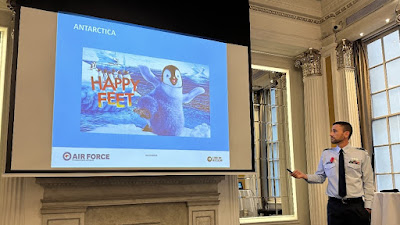169. Honourable Company of Air Pilots Cobham Lecture RAF Club 24 April 2024
He started
by saying that the Royal New Zealand Air Force (RNZAF) is operating aircraft to
the coldest, driest and windiest continent on Earth – Antarctica. Supporting scientific exploration and other
national interests on the world’s fifth largest continent, the RNZAF has been
flying to Antarctica continuously since 1965 – making it the longest continuous
New Zealand Defence Force (NZDF) operation.
Within these nearly seven decades of Antarctic operations, the RNZAF has
operated six aircraft types and accumulated thousands of flying hours operating
to one of the world’s most remote and challenging environments.
Amundsen–Scott
South Pole Base was set up in 1957 by the USA after Amundsen reached the Pole
in in 1911 and Scott in 1912. New Zealand established Scott Base on Ross Island
in 1957. Since then many other countries
have created bases on Antarctica. The ambition was to use the Antarctic for
peaceful purposes, where there was freedom of scientific research and
cooperation. Scientific observations are developed and shared.
He described
the history of RNZAF flying to the continent and detailed a typical ‘ice
flight’, including fuel planning, flight preparation, the flight itself, and
operating in and out of McMurdo airfield – a runway built on sea ice. It was fascinating to hear his first-hand
experience and stories on some of the more unique challenges, including weather
deterioration past the point of safe return.
The base is
regularly serviced from Christchurch and each flight requires careful planning.
The base is regularly susceptible to low cloud cover, and snow and ice cover,
which inhibit landing. Before taking off the weather and forecast are checked
and a decision made as to whether to fly. The distance is 2072 nautical miles and
a decision has to be made when to turn round as there is insufficient fuel
capacity on the aircraft for a return trip. One advantage is that in winter
there is little worry about overshooting the runway as the ice extends for
miles.
It was a
fascinating presentation, well attended by other Livery Masters. I am very grateful to the Air Pilots for a
most enjoyable evening.




Comments
Post a Comment